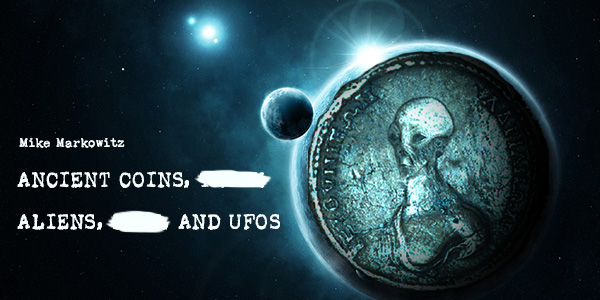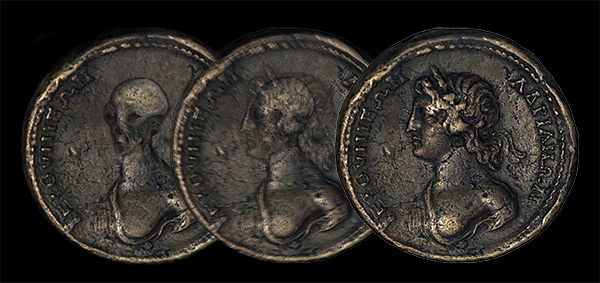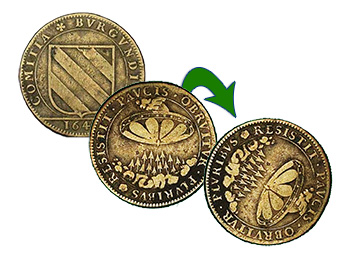
By Mike Markowitz for CoinWeek …..
On the wall of his office in the FBI building’s basement, Special Agent Fox Mulder of the TV series The X-Files has a UFO poster that proclaims: I WANT TO BELIEVE.
The sentiment is widely shared, even among numismatists, who are generally a rather skeptical bunch.
The “Alien” Coin
In October 2016, several British tabloids published a photograph of a silver coin of uncertain size with a Greek inscription[1]. The coin portrait depicts a gaunt draped bust resembling a so-called “Grey alien”[2]. Grey aliens are extraterrestrial humanoids associated with contemporary UFO mythology.
The source of the image is credited to the UFO web site mysteriousearth.net, where discovery of the coin is ascribed to a “group of people who worked on the renovation of a house in southern Egypt”[3].
It is clearly a hoax. The lack of any attribution (weight, dimensions, date, image of the reverse, etc.) raises the level of suspicion to an astronomical level.
My first impression is that this was a real coin or medallion extensively tooled in order to turn the portrait of a ruler or deity into the likeness of an alien – like an elaborate “hobo nickel”[4]. Hobo nickels are American five-cent pieces that have been carved and tooled, often with great skill, into novel or startling forms. The craft became popular during the Great Depression (1929 – 1939) among “hobos”, (homeless itinerant workers who had a lot of time on their hands).
The Plot Thickens
Why would anyone create such a fantasy coin? My first thought was that the object was a deliberate forgery intended to deceive gullible collectors, but on reflection it became clear that no serious collector would be taken in by such an obviously tooled fake. Could it have been the creation of UFO enthusiasts, attempting to fabricate evidence for “Ancient Astronaut” theories?
A little research revealed that it’s not even a real artifact, but a heavily retouched (“photoshopped”) image of an actual Roman medallion in the famous collection of the Cabinet de Médailles in Paris. The hoax was uncovered by computer scientist Ralf Bülow[5], as credited by author Jason Colavito on his web site[6].
The very rare original medallion depicts Dionysus, the god of wine and abandon. The other side (technically the obverse) bears an idealized portrait of Antinous, the beloved young companion of the Roman emperor Hadrian. Antinous, about 18 years of age, drowned in the Nile River in 130 CE. Hadrian was distraught, and had the youth declared a god, raising temples in his honor throughout the Roman East–notably in his birthplace, Claudiopolis or Bithynion in the province of Bithynia (now Bolu, Turkey). This is where the medallion was struck.

The image of the medallion seems to have been taken from a web site dedicated to Antinous[7], who has become something of a hero for gay history. The blue fabric background is a dead giveaway that the original photograph was a museum display case. A determined image search turned up a sharper image on Wikipedia with the fabric background “shopped” out[8].
The digital trail led to a Brazilian UFO site[9], where I learned (thanks to good Portuguese translation on my web browser) that the hoax image came from DesignCrowd, an Australian graphic design crowdsource web site. In April 2011, DesignCrowd conducted a “Coin of the Realm” contest, challenging graphic designers to create images of celebrities on coins[10].
A user with the handle “Kryptomaniacle” submitted a previously created image just 20 minutes before the contest closed, identifying the portrait as “The historically obscure Grapnok; largely responsible for three of the Seven Wonders of the World.” The submission won third place. Technically “Grapnok” was not a “celebrity” and bent the contest rules, as Kryptomaniacle admitted in a subsequent message.
 It was not a hoax; it was a playful, creative joke. The hoax developed when the tabloids took the image and turned it into a clickbait UFO story.
It was not a hoax; it was a playful, creative joke. The hoax developed when the tabloids took the image and turned it into a clickbait UFO story.
The “UFO” Jetons
To further confuse the situation, the same “Egyptian” find was given as the source of some 17th-century French jetons bearing images of disk-shaped objects floating in the clouds. Jetons are (mostly) copper or brass tokens, typically 20 to 28 mm in size, produced in thousands of different designs across Europe from the 13th to the 17th centuries. They were originally used in accounting and computation (like the beads of an abacus). They also served like poker chips or “play money” in games. They were not coins, and were not struck by official mints, but they are highly collectable and sometimes confused with coins.
A 1648 jeton from the Burgundy region of France appears to show a UFO hovering over a rocky pine forest. But when the image is rotated into the proper orientation (based on the reading of the Latin motto (which translates ”It resisted a few, but was overcome by many”), it shows a shield being held up against a storm of arrows coming down from the clouds. This is a very conventional allegorical image with no extraterrestrial implications.
A more challenging example is a 1656 copper jeton that very clearly shows a disk with a central spindle floating above a landscape. The enigmatic Latin motto Opportunus Adest translates as “It arrives at a fortunate time.” The designs of jetons were frequently reworked and modified, and a white metal copy shows a floating object that is not at all saucer-like but might be a Baroque-style parade shield.
 The idea of shields that fall from the sky as divine gifts or tokens of protection is very ancient.
The idea of shields that fall from the sky as divine gifts or tokens of protection is very ancient.
According to legend, in the time of Numa Pompilius (second king of Rome, lived 753–673 BCE) a bronze shield, the ancile, fell from heaven[11]. Numa had 11 identical replicas made (to protect the identity of the real one), and established a priesthood–the Salii, or leaping priests–to care for them, and to carry them in procession on special occasions.
This famous story was part of a classical education, and would have been familiar to the early modern Europeans who used jetons. The elaborately fluted steel shields that came into use in the 16th century often bear a remarkable similarity to modern images of UFOs. A spectacular example is a 1594 Dutch jeton[12], showing the hand of God reaching down from heaven to interpose a symbolic shield of divine protection between the Netherlanders and the Spanish Army. There is no historical evidence that any extraterrestrial spacecraft were involved.
* * *
Notes
[2] https://en.wikipedia.org/wiki/Grey_alien
[4] https://en.wikipedia.org/wiki/Hobo_nickel
[5] Identified as head of the Computer Museum of Applied Sciences Kiel, Germany.
[7] http://antinopolis.org/gallery/icons/coins.html
[8] https://commons.wikimedia.org/wiki/File:Medallion_Antinous_CdM.jpg
[9] http://www.assombrado.com.br/2016/11/as-moedas-extraterrestres-uma-incrivel.html
[10] http://www.designcrowd.com/community/contest.aspx?id=1673157
[11] https://en.wikipedia.org/wiki/Ancile
[12] Nomos Auction 13, 7 October 2016. Lot 19: realized $470 USD.
References
Innes, Brian. Fakes and Forgeries: The True Crime Stories of History’s Greatest Deceptions. Pleasantville, NY (2005)
Jones, Mark (ed.) Fake? The Art of Deception. Berkeley (1990)
Lambert, Royston. Beloved and God: The Story of Hadrian and Antinous. New York (1984)
O’ Donoghue, Rachel. “Spooky ancient coins ‘proof aliens have visited Earth’.” The Sun (13 October 2016)
Sayles, Wayne. Classical Deception: Counterfeits, Forgeries and Reproductions of Ancient Coins. Iola, WI (2001)
von Däniken, Erich. Chariots of the Gods. New York (1970)
von Mosch, Hans-Christoph. “Die Antinoos-Medaillons von Bithynion-Klaudiopolis.” Schweizer Numismatische Rundschau (Swiss Numismatic Review) 80 (2001)
NGC-Certified Ancient Roman Coins Currently Available on eBay
[wpebayads]




